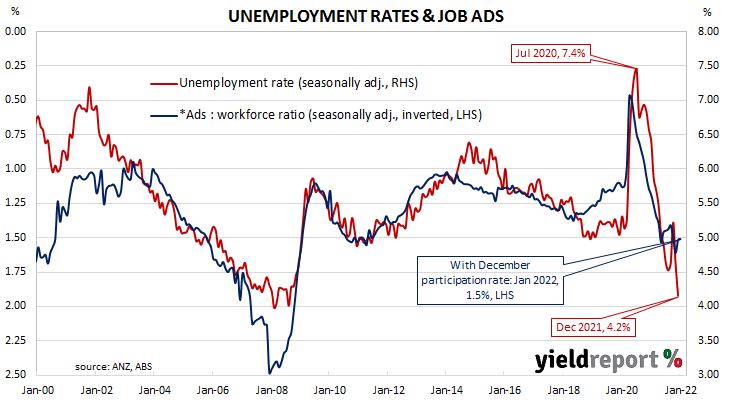Summary: Job ads down 0.3% in January; 27.3% higher than same month in 2021; Omicron cases no hindrance to usual post-New Year rebound; ANZ expects job-switching rate to rise, may not have seen advertising peak yet; ads-to-workforce ratio steady at 1.5%.
From mid-2017 onwards, year-on-year growth rates in the total number of Australian job advertisements consistently exceeded 10%. That was until mid-2018 when the annual growth rate fell back markedly. 2019 was notable for its reduced employment advertising and this trend continued into the first quarter of 2020. Advertising plunged in April and May of 2020 as pandemic restrictions took effect but then recovered quite quickly.
According to the latest ANZ figures, total advertisements declined by 0.3% in January on a seasonally-adjusted basis. The fall followed a 5.8% drop in December and a 9.6% gain in November after revisions. On a 12-month basis, total job advertisements were 27.3% higher than in January 2021, down from December’s revised figure of 32.9%.
“Although ANZ Job Ads fell by 0.3% in January, they rose steeply on a weekly basis through the month, as is usual following the seasonal Christmas/New Year low. This was despite the large number of Omicron cases in the community, reflecting the resilience in labour demand and the widespread view that Omicron would only be a temporary setback,” said ANZ senior economist Catherine Birch.
Commonwealth Government bond yields rose on the day, especially at the short end. By the close of business, the 3-year ACGB yield had jumped 7bps to 1.52% while 10-year and 20-year yields both finished 3bps higher at 2.01% and 2.48% respectively.
Birch is expecting advertising to increase in the short-term. “After Omicron, we expect the job-switching rate to rise as workers change to better, higher paying jobs in 2022. This would mean more people quitting their current jobs, which should translate into a greater number of new job ads, raising ANZ Job Ads as well as the National Skills Commission measure. So we may not have seen the peak yet.”
The inverse relationship between job advertisements and the unemployment rate has been quite strong (see below chart), although ANZ themselves called the relationship between the two series into question in early 2019. A rising number of job advertisements as a proportion of the labour force is suggestive of lower unemployment rates in the near-future while a falling ratio suggests higher unemployment rates will follow.
In 2008/2009, advertisements plummeted and Australia’s unemployment rate jumped from 4% to nearly 6% over a period of 15 months. When a more dramatic fall in advertisements took place in April 2020, the unemployment rate responded much more quickly.



